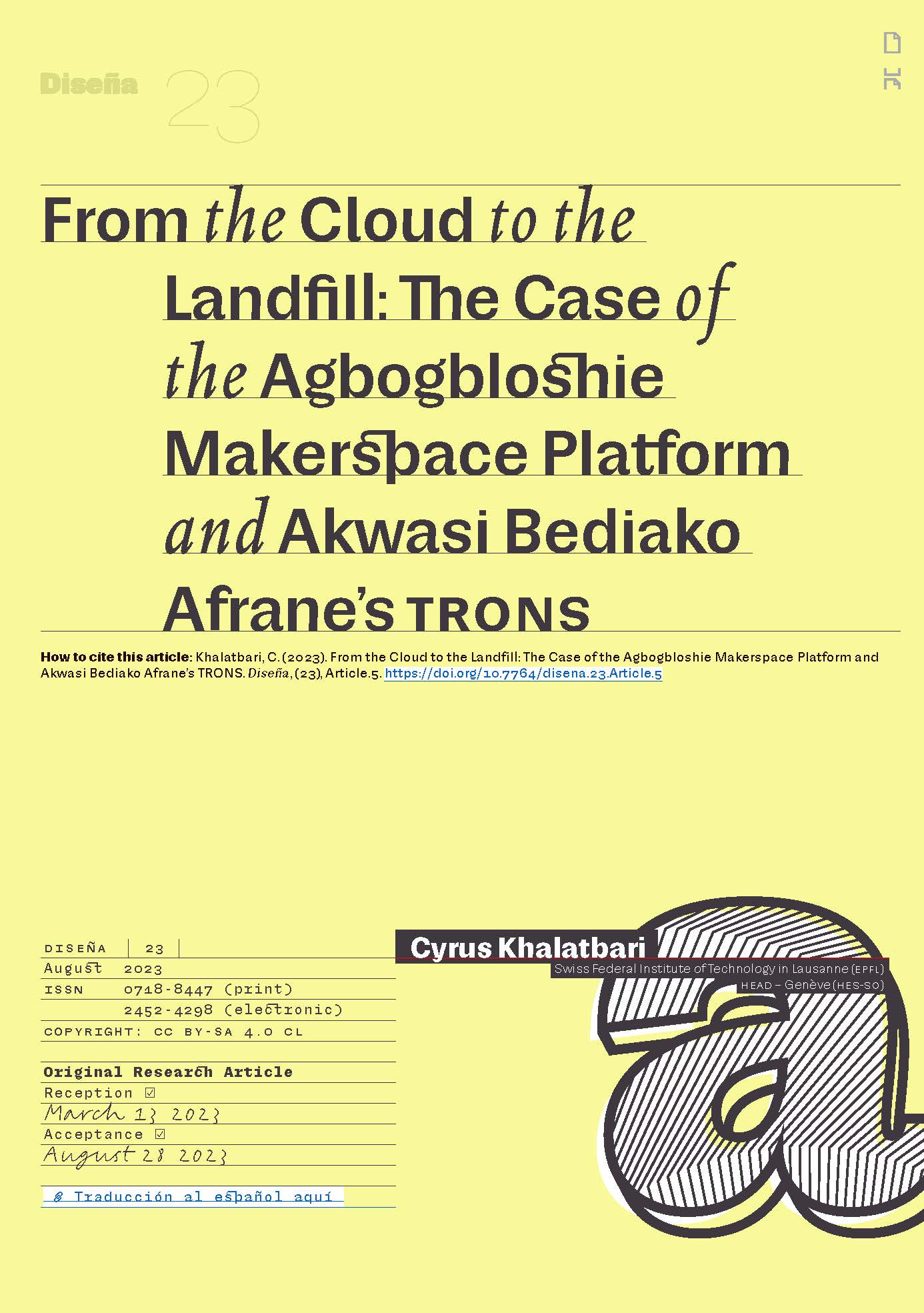From the Cloud to the Landfill: The Case of the Agbogbloshie Makerspace Platform and Akwasi Bediako Afrane’s TRONS
Main Article Content
Abstract
This contribution sheds light on discarded electronics repair in Accra, Ghana. After placing these practices in dialogue with the Western and Eurocentric narratives around the materiality of digital interactions and infrastructure, it delves into two arts and design contexts that gravitate around the electronic waste landfill and processing site of Agbogbloshie (Ghana). The first case study is the Agbogbloshie Makerspace (AMP), a critical making (and unmaking) platform empowering local repairers and dismantlers through open-source collaborative design methods. The contribution then focuses on the work of Akwasi Bediako Afrane, a Ghanaian media artist who re-appropriates discarded computers to critique and speculate on our sociotechnical condition. Situating these initiatives in the light of our broader dominant internet and computing narratives, the article situates the importance of these practices in order to tackle and raise awareness about the planetary electronic waste condition we live in.
Downloads
Article Details

This work is licensed under a Creative Commons Attribution-ShareAlike 4.0 International License.

This work is licensed under a Creative Commons Attribution-ShareAlike 4.0 International license.
COPYRIGHT NOTICE
All contents of this electronic edition are distributed under the Creative Commons license of "Attribution-ShareAlike 4.0 Internacional" (CC-BY-SA). Any total or partial reproduction of the material must mention its origin.
The rights of the published images belong to their authors, who grant to Diseña the license for its use. The management of the permits and the authorization of the publication of the images (or of any material) that contains copyright and its consequent rights of reproduction in this publication is the sole responsibility of the authors of the articles.
References
Afrane, A. B. (2022). Game of TRONS: A Play Around With Consumer Electronic Gadgets. TRONSpuppet. https://www.gameoftrons.com
Agamben, G. (2009). “What Is an Apparatus?” and Other Essays. Stanford University Press.
Akese, G., Beisel, U., & Muntaka Chasant, M. (2022, July 21). Agbogbloshie: A Year after the Violent Demolition. African Arguments. https://africanarguments.org/2022/07/agbogbloshie-a-year-after-the-violent-demolition/
Barbrook, R., & Cameron, A. (1996). The Californian Ideology. Science as Culture, 6(1), 44–72. https://doi.org/10.1080/09505439609526455
Baxter, G., & Sommerville, I. (2011). Socio-technical Systems: From Design Methods to Systems Engineering. Interacting with Computers, 23(1), 4–17. https://doi.org/10.1016/j.intcom.2010.07.003
Buchanan, R. (2001). Design Research and the New Learning. Design Issues, 17(4), 3–23. https://doi.org/10.1162/07479360152681056
Burrell, J. (2012). Invisible Users: Youth in the Internet Cafés of Urban Ghana. MIT Press.
“Crisis in Agbogbloshie, Ghana, Caused by Forced Dismantlement of the Landfill.” (2021, July 10). Electrònica Justa. https://electronicajusta.net/crisis-in-agbogbloshie-ghana-caused-by-forced-dismantlement-of-the-landfill/
Dunne, A., & Raby, F. (2013). Speculative Everything: Design, Fiction, and Social Dreaming. MIT Press.
Efthymiou, L., Mavragani, A., & Tsagarakis, K. P. (2016). Quantifying the Effect of Macroeconomic and Social Factors on Illegal E-Waste Trade. International Journal of Environmental Research and Public Health, 13(8), Article 8. https://doi.org/10.3390/ijerph13080789
Emery, F. E., & Trist, E. L. (1960). Socio-technical Systems. In C. W. Churchman & M. Verhulst (Eds.), Management Sciences, Models and Techniques (Vol. 2, pp. 83–97). Pergamon Press.
Ensmenger, N. (2018). The Environmental History of Computing. Technology and Culture, 59(4), S7–S33. https://doi.org/10.1353/tech.2018.0148
Gaboury, J. (2018). Critical Unmaking: Toward a Queer Computation. In J. Sayers (Ed.), The Routledge Companion to Media Studies and Digital Humanities (pp. 483–491). Routledge.
Gabrys, J. (2013). Digital Rubbish: A Natural History of Electronics. University of Michigan Press.
Hertz, G. (2009). What is Critical Making? Current. https://current.ecuad.ca/what-is-critical-making
Hertz, G., & Parikka, J. (2012). Zombie Media: Circuit Bending Media Archaeology into an Art Method. Leonardo, 45(5), 424–430. https://doi.org/10.1162/LEON_a_00438
Hu, T.-H. (2016). A Prehistory of the Cloud. MIT Press.
Latour, B. (1999). Pandora’s Hope: Essays on the Reality of Science Studies. Harvard University Press.
Lundgren, K. (2012). The Global Impact of e-Waste: Addressing the Challenge [Report]. International Labour Organization. http://www.ilo.org/sector/Resources/publications/WCMS_196105/lang--en/index.htm
Lupton, E., & Miller, J. A. (1992). The Bathroom, the Kitchen and the Aesthetics of Waste: A Process of Elimination. Princeton Architectural Press.
Moore, J. W. (2015). Capitalism in the Web of Life: Ecology and the Accumulation of Capital. Verso.
Osseo-Asare, D., & Abbas, Y. (2015). Investigating 3E-materials at Agbogbloshie in Accra, Ghana. Proceedings of the Engineering4Society 2015 Conference, 41–50. https://doi.org/10.1109/Engineering4Society.2015.7177898
Osseo-Asare, D., & Abbas, Y. (2021). Occupying Africa: Prototyping a Transformal Makerspace Network. Architectural Design, 91(5), 62–69. https://doi.org/10.1002/ad.2733
Perkins, D. N., Drisse, M.-N. B., Nxele, T., & Sly, P. D. (2014). E-Waste: A Global Hazard. Annals of Global Health, 80(4), Article 4. https://doi.org/10.1016/j.aogh.2014.10.001
Potter, C., Osseo-Asare, D., & M’Rithaa, M. K. (2019). Crafting Spaces Between Design and Futures: The Case of the Agbogbloshie Makerspace Platform. In S. Candy & C. Potter (Eds.), Design and Futures (Vol. 1). Tamkang University Press.
Scanlan, J. (2005). On Garbage. Reaktion.
Seidu, F., & Kaifie, A. (2022). The End of Informal E-waste Recycling in Accra, Ghana? Annals of Work Exposures and Health, 66(8), 1091–1093. https://doi.org/10.1093/annweh/wxac050
Sengers, P., Boehner, K., David, S., & Kaye, J. “Jofish.” (2005). Reflective Design. Proceedings of the 4th Decennial Conference on Critical Computing: Between Sense and Sensibility, 49–58. https://doi.org/10.1145/1094562.1094569
Sterne, J. (2007). Out with the Trash: On the Future of New Media. In C. R. Acland (Ed.), Residual Media (pp. 16–31). University of Minnesota Press.
Winner, L. (1980). Do Artifacts Have Politics? Daedalus, 109(1), 121–136.
Wittsiepe, J., Feldt, T., Till, H., Burchard, G., Wilhelm, M., & Fobil, J. N. (2017). Pilot Study on the Internal Exposure to Heavy Metals of Informal-level Electronic Waste Workers in Agbogbloshie, Accra, Ghana. Environmental Science and Pollution Research International, 24(3), 3097–3107. https://doi.org/10.1007/s11356-016-8002-5

